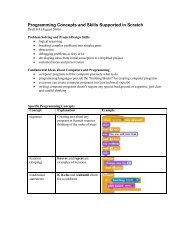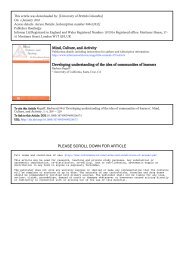Gaming Literacies: A Game Design Study in Action - MIT
Gaming Literacies: A Game Design Study in Action - MIT
Gaming Literacies: A Game Design Study in Action - MIT
You also want an ePaper? Increase the reach of your titles
YUMPU automatically turns print PDFs into web optimized ePapers that Google loves.
<strong>Gam<strong>in</strong>g</strong> <strong>Literacies</strong>: A <strong>Game</strong> <strong>Design</strong> <strong>Study</strong> <strong>in</strong> <strong>Action</strong> 317<br />
action. The mean<strong>in</strong>g of an action <strong>in</strong> a game resides <strong>in</strong> the relationship between<br />
action and outcome. The relationship between actions and outcomes<br />
<strong>in</strong> a game are both discernable and <strong>in</strong>tegrated <strong>in</strong>to the larger context of the<br />
game. Discernability means that a player can perceive the immediate outcome<br />
of an action. Integration means that the outcome of an action is woven<br />
<strong>in</strong>to the game system as a whole.<br />
Players want to feel like the choices they make <strong>in</strong> the game are strategic<br />
and <strong>in</strong>tegrated. <strong>Game</strong> designers must design the rules of a game <strong>in</strong> such a<br />
way that each decision a player makes feels connected to previous decisions,<br />
as well as to future decisions encountered <strong>in</strong> the course of play. Degrees of<br />
randomness and chance are two tools that a game designer has at his or her<br />
disposal to balance the amount of strategic choice a player has <strong>in</strong> a game.<br />
Choice is related to the goal of a game, which is often composed of smaller<br />
sub-goals a player must meet to w<strong>in</strong> the game. All games have a w<strong>in</strong> or loss<br />
condition, which <strong>in</strong>dicates what must be achieved <strong>in</strong> order to end the game.<br />
Because all games must have some k<strong>in</strong>d of quantifiable outcome to be considered<br />
a game by traditional def<strong>in</strong>itions, def<strong>in</strong><strong>in</strong>g the w<strong>in</strong> and loss states for<br />
a game is critical feature of a game’s design.<br />
<strong>Game</strong> design models player <strong>in</strong>teraction on several levels: human-to-human<br />
<strong>in</strong>teraction, human-to-technology <strong>in</strong>teraction, human-to-game <strong>in</strong>teraction.<br />
• The Core mechanics are the experiential build<strong>in</strong>g blocks of player<br />
<strong>in</strong>teractivity, which represent the essential moment-to-moment<br />
activity of the player, someth<strong>in</strong>g that is repeated over and over<br />
throughout the game. Dur<strong>in</strong>g a game, the core mechanic creates<br />
patterns of behavior, and is the mechanism through which players<br />
make mean<strong>in</strong>gful choices. Mechanics <strong>in</strong>clude activities like trad<strong>in</strong>g,<br />
shoot<strong>in</strong>g, runn<strong>in</strong>g, collect<strong>in</strong>g, talk<strong>in</strong>g, captur<strong>in</strong>g territory, etc.<br />
<strong>Game</strong> design relies on the design of compell<strong>in</strong>g, <strong>in</strong>teractive core<br />
mechanics.<br />
• Interaction between the player and an <strong>in</strong>put device allows the<br />
player to control elements with<strong>in</strong> the game space. <strong>Design</strong> of the<br />
<strong>in</strong>put device is connected to the design of the game <strong>in</strong>terface,<br />
which organizes <strong>in</strong>formation and allows a player to play the game.<br />
A game <strong>in</strong>terface can be simple or complex, but should always<br />
provide a player with access to the elements and activities of the<br />
game.<br />
• Interaction between different game components is def<strong>in</strong>ed by rules<br />
that describe what happens when these components <strong>in</strong>teract. Does<br />
the ball (component) bounce (rule) off the wall (component) or<br />
smash (rule) a hole (object) <strong>in</strong> it







